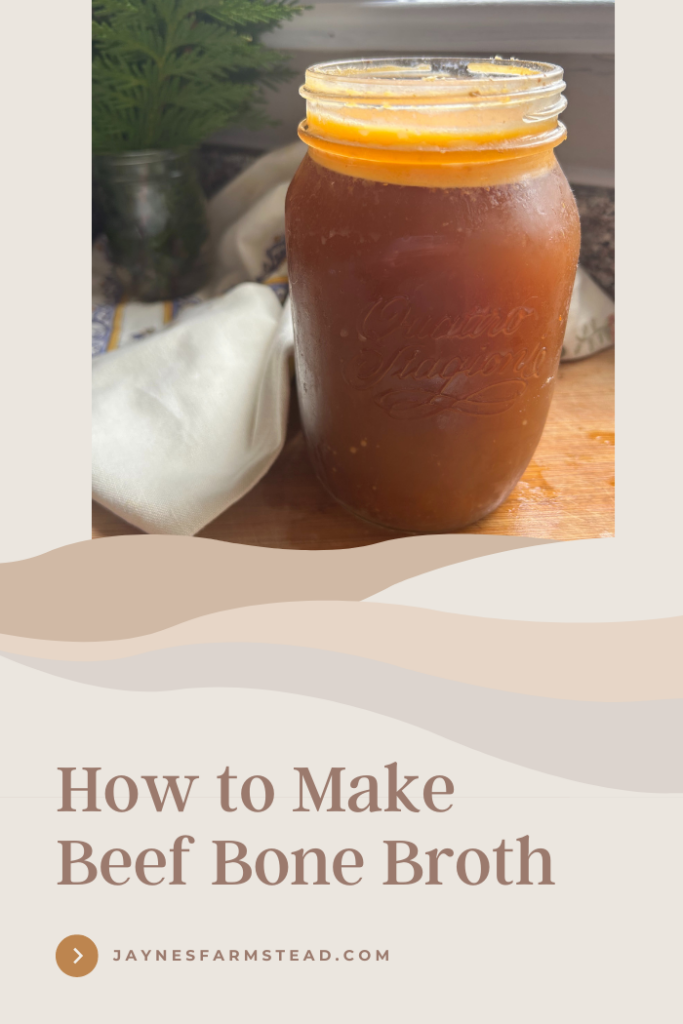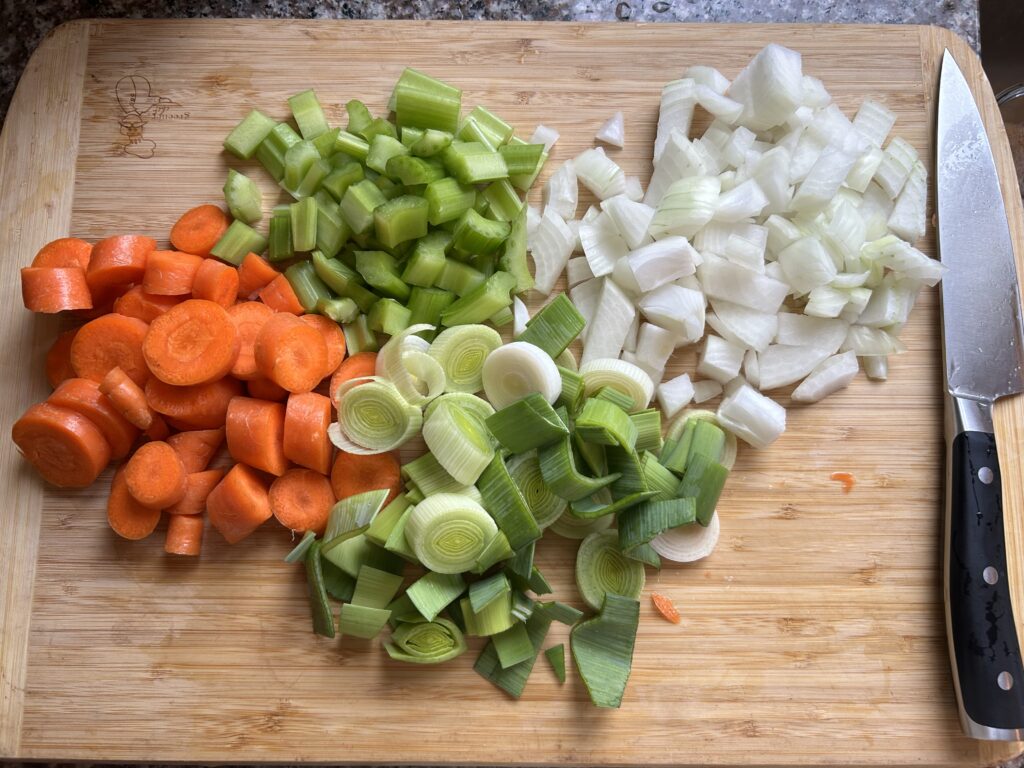
We owe a great debt to our ancestors. Through wars, plague, ice ages they survived. I would dare to even say at certain times they thrived. I mean, would we have made it this far if they hadn’t? If they were just barely hanging on? Well you want to know their secret? Bone deep nourishment. Bone broth is as ancient as our human bodies. We still have the same physiology as early humans and require the same nourishment if not more so. And I personally believe the best way to honor them is by taking the best care possible of our bodies. This is why learning how to make beef bone broth is incredibly important for your well being.
Bone broth supports healthy joints, boosts gut health and helps improve metabolism among many other things. Bone broth contains minerals that the body can easily absorb, collagen, essential amino acids and the list goes on.
If you’ve been following along on my other posts, you know I purchased a quarter of a cow share this year. Included in my share were soup bones. So I decided to make a beef bone broth that we can sip on and use in other recipes. Beef broth is something I use often in my cooking and the store bought stuff just isn’t up to par.

Is Making Beef Bone Broth difficult?
Making beef bone broth is pretty simple. You start by roasting the bones at 400℉ for 20-30 minutes. Add the bones to a stock pot or any large pot you have, making sure to scrape the roasting pan and adding any leftover bits to the pot. Next, add a mix of vegetables such as a mirepoix (carrots, onion, celery). Fill with water until everything is covered. Add a splash of apple cider vinegar. Bring to a boil and then lower heat and simmer for 24 hours.
Why Beef Bone Broth?
Bone broth involves cooking connective tissues to produce a nutrient filled protein called collagen and minerals. The connective tissue comes from the bones, joints, skin, tendons, ligaments and cartilage of an animal. This is why pasture raised/grass-fed animals are ideal since these animals tend to have stronger bones resulting in a more gelatinous broth. It is this gelatin or cooked collagen that makes beef bone broth a healing superfood.
Why Do You Roast the Bones First?
Roasting the bones prior to simmering in the pot helps to add a lot of flavor to the broth. Some people will simply roast the bones in a dutch oven and then use that same pot to make their broth. This is a fine option if you are not using a stock pot. I use a stock pot because they really are meant for simmering large amounts of liquid over a long period of time. They also don’t weigh much making them easier to handle even when they are filled to the brim.
What Bones are Best for Beef Bone Broth?
It is best to use a variety of bones when making beef bone broth. Some possibilities are knuckles, feet, marrow, oxtail, neck. Neck bones are an excellent choice because they are usually inexpensive and come with a lot of meat still attached to the bone. Marrow is also packed with flavor and loads of nutrients. In this version of broth I used knuckle bones, marrow, and oxtail. I also added scraps of meat from a porterhouse we had the night before.
The bones need to be roasted before simmering for 24 hours. Before roasting the bones I smothered them in tomato paste because the acidity helps to pull the nutrients from the bones.

What vegetables go in beef bone broth?
Broths should be kept simple. Mirepoix is the best flavor base for broths. Mirepoix is a combination of chopped onion, carrot and celery. You can add garlic but it can be too overpowering.
To salt or not to salt?
Many people prefer not to add salt when they are making beef bone broth. The reason being that salt is an ingredient in other dishes and you run the risk of over salting the meals you make with it. I personally add salt to my beef bone broth since it is dual purpose in my home as we also enjoying simply sipping it.
How long to cook beef bone broth?
Beef Bone Broth needs to simmer on the stove for 12-48 hours to get all the nutrients from the bones. Use the low and slow method for bone broth and keep the pot covered with a lid. Periodically skim any scum that may rise to the surface and discard.
What Can I use Beef Bone Broth for?
Braising, simmering, sipping, soups, stews, sauces. In the last week alone I have used beef bone broth in multiple recipes including shepherds pie and beef stew. Check out my Shin Beef Stew recipe.

What is the Benefit of Adding Tomato Paste vs. apple cider Vinegar?
Both tomato paste and apple cider vinegar are great to add to broth because the acidity helps break down the connective tissue in the bones. Tomato paste also adds a depth of flavor and color to the broth. While apple cider vinegar aids in drawing minerals out of the bones. I use both in my beef bone broth. I smother the tomato paste over the bones before roasting. Then I add a dash of apple cider vinegar when I fill the pot with water.

How to make Beef Bone Broth on the Stove
Ingredients:
4-5 pounds of beef bones such as knuckle, bone marrow, neck, oxtail, shank and feet
1 can tomato paste
1 onion chopped
2 carrots chopped
2 celery ribs chopped
1 leek chopped
sprig of fresh thyme
bay leaf
1 teaspoon salt
8-10 peppercorns
apple cider vinegar
Meaty/fatty scraps or trimmings from porterhouse, ribeye, t-bone, roast if you have. This is optional but i highly recommend it.
Stock pot or dutch oven
Instructions
1. Preheat oven to 400℉
2. Arrange assorted bones on a baking sheet or roasting pan and coat with tomato paste. If you are using a dutch oven you can roast the bones directly in the pot. Roast for 20-30 minutes.
3. Meanwhile, chop onions, carrot, celery and leek and set aside.
4. When bones are done, add them to the stock pot. Pour 1/2 cup of water into the pan the bones roasted in and scrape up any bits (fond) that are stuck to the bottom. Then add them to the stock pot.
5. Add the chopped vegetables to the pot with any meat trimmings if you are using. Add thyme, bay leaf, salt, peppercorns, and a splash of apple cider vinegar.
6. Fill pot with water until bones are completely covered. Cover with lid.
7. Bring to a boil and then reduce to a simmer. Leave to simmer for 12-48 hours.
8. Remove from heat and allow time to cool before straining. Store in mason jars or other containers. put in the refrigerator and allow it to solidify. Once solid the fat will all rise to the top and you can scoop the fat off to use for cooking. Leaving a layer of fat on keep the broth fresh longer.
9. Use within 1 week or freeze.
In conclusion
We as a culture have forgotten or were never taught that there are many more nutritious parts of animals than just the muscle meat. In other parts of the world, bone broth has been used medicinally for centuries. Traditional cultures have used broth to treat everything from colds and GI issues to depression, joint pain and hair loss. My family loves broth and it is by far my favorite food to cook for them!


Beef Bone Broth
Equipment
- Stock pot or dutch oven
Ingredients
- 4-5 pounds beef bones such as knuckle, bone marrow, neck, oxtail, shank and feet
- 1 can tomato paste
- 1 onion chopped
- 2 carrots chopped
- 2 celery ribs chopped
- 1 leek chopped
- 1 sprig of thyme
- 1 bay leaf
- 1 teaspoon salt
- 8-10 peppercorns
- apple cider vinegar
- Meaty/fatty scraps or trimmings from porterhouse, ribeye, t-bone, roast if you have. This is optional but I highly recommend it.
Instructions
- Preheat oven to 400℉
- Arrange assorted bones on a baking sheet or roasting pan and coat with tomato paste. If you are using a dutch oven you can roast the bones directly in the pot. Roast for 20-30 minutes.
- Meanwhile, chop onions, carrot, celery and leek and set aside.
- When bones are done, add them to the stock pot. Pour 1/2 cup of water into the pan the bones roasted in and scrape up any bits (fond) that are stuck to the bottom. Then add them to the stock pot.
- Add the chopped vegetables to the pot with any meat trimmings if you are using. Add thyme, bay leaf, salt, peppercorns, and a splash of apple cider vinegar.
- Fill pot with water until bones are completely covered. Cover with lid.
- Bring to a boil and then reduce to a simmer. Leave to simmer for 12-48 hours.
- Remove from heat and allow time to cool before straining. Store in mason jars or other containers. put in the refrigerator and allow it to solidify. Once solid the fat will all rise to the top and you can scoop it off to use for cooking. Leaving a layer of fat on keep the broth fresh longer.
- Use within 1 week or freeze.

Before coffee, a cup warm beef broth is the prefect way to start your day!